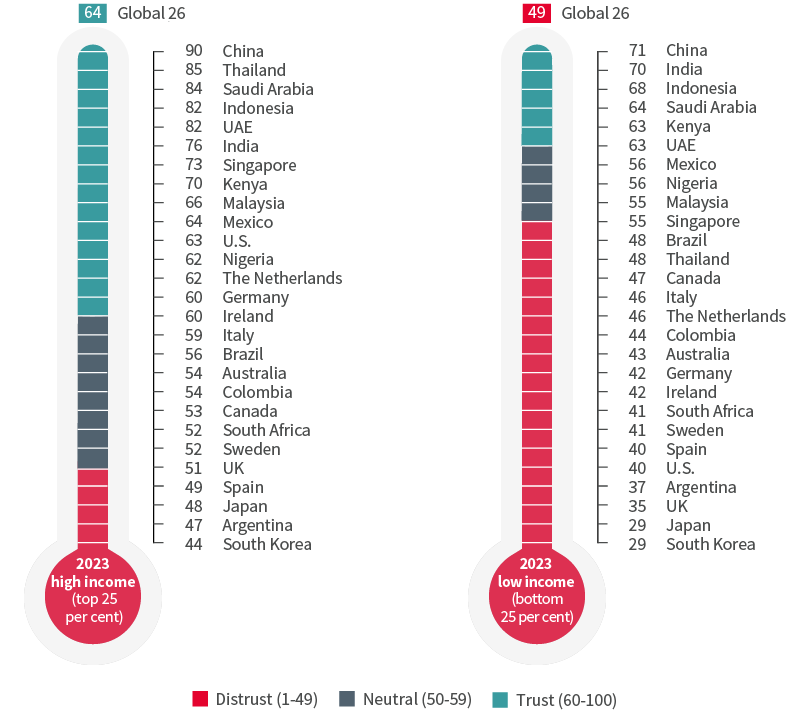Read this article to understand:
- The growing momentum behind the concept of a living wage
- The direct and broader economic benefits for companies of paying a living wage
- How investors can engage with companies on the issue
The Global Living Wage Coalition defines a living wage as: “The remuneration received for a standard workweek by a worker in a particular place sufficient to afford a decent standard of living for the worker and her or his family. Elements of a decent standard of living include food, water, housing, education, health care, transportation, clothing, and other essential needs including provision for unexpected events.”1
According to the International Labour Organisation (ILO), living wages are essential to enable decent living standards and incomes for workers and their families while ensuring the sustainability of the companies that employ them.2
The ILO estimated that, in 2020, 19 per cent of workers globally earned less than they needed to escape poverty.3 Living wages can therefore be a route to tackling poverty and meeting some of the UN Sustainable Development Goals (SDGs), in particular SDG 1 (no poverty) and SDG 8 (decent work and economic growth), while supporting SDG 10 (reducing inequalities).
Growing momentum
As a result, there has been increased interest in the living wage in recent years, particularly in the context of growing inequality. According to the Business Commission to Tackle Inequality (BCTI), the top ten per cent of earners receive nearly 52 per cent of total global pay, while the lowest-paid half of workers receive just 8.5 per cent.4
In the US, for instance, the federal minimum wage of $7.25 per hour is far lower than the living wage. The Massachusetts Institute of Technology estimates a single mother with two children earning the federal minimum wage needs to work 252 hours a week to make a living wage, the equivalent of six full-time jobs.5 Other estimates show that, in 2022, 51 per cent of workers at Russell 1000 companies, representing around 15 per cent of the employed population, were not earning a family-sustaining living wage.6
In addition, the absence of a living wage can increase gender and racial inequalities. In the US, where most data are available, over 50 per cent of Latinx and African Americans earn less than $15 an hour in most states, as do 40 per cent of women, compared with less than 40 per cent of white people and men overall.7
In contrast, the UK’s national minimum wage is updated yearly, meaning it only lags the living wage by £1.58 – although it only applies to over-23s, meaning many younger people work for significantly lower wages, often in difficult sectors such as retail and hospitality.8
Labour unrest and cost-of-living crisis
“COVID-19 exposed many of these existing fault-lines of inequality, contrasting poor health-and-safety conditions for low-paid workers in meat-processing facilities and care homes with the rise in tech-enabled remote working for white-collar workers,” says Vaidehee Sachdev, social pillar lead at Aviva Investors.
Persistent inflation and the cost-of-living crisis have increased pressure on companies to guarantee workers receive a wage they can live on
“In response, there has been an increase in organised labour in some sectors in an attempt to improve wages and conditions given the difficulties workers experienced during the pandemic,”9 she adds. “More recently, persistent inflation and the cost-of-living crisis have increased pressure on companies to guarantee workers receive a wage they can live on.”
Companies that do not pay a living wage also expose themselves to other human rights risks like excessive working hours, exploitative working conditions, forced labour and child labour.10 This in turn can increase the risks of negative consumer sentiment and legal and regulatory risks as governments look to introduce more stringent human rights regulation. Several countries in Europe and Latin America have increased minimum wages, while US President Joe Biden has recently spoken out in support of living wages. The legal and regulatory environment is also increasingly addressing living wages, especially in Europe.11,12,13,14
Against this backdrop, a growing number of companies are focusing on the issue, as are organisations looking to support businesses in this approach and provide certification (Figure 1).
Figure 1: Some of the key living wage methodologies and benchmarks
| Anker Methodology | A methodology to calculate living-wage levels through engaging local people and organisations. The living wage is calculated to provide a “basic but decent standard of living” for a typical-sized family. |
| Anker Reference Values | Estimates of living wage or income for rural and urban areas in countries not yet covered by a full Anker Methodology benchmark. The values provide internationally comparable data on 24 additional countries to help companies assess and prioritise living-wage risk. |
| Fair Wage Network’s Living Wage Database | Paid-for wage benchmarks for 200 countries and more than 1,500 regions and cities. |
| Global Living Wage Coalition Database | Information on living wages in 37 regions or countries. |
| IDH Benchmark Finder | A database of IDH-recognised living-wage benchmarks for over 140 countries. |
| IDH Benchmark Series | A list of living-wage methodologies recognised by IDH as having met nine quality criteria. |
| National methodologies and benchmarks | For example, Living Wage for US adapts the Anker Methodology to produce its Living Wages Map; see also MIT’s Living Wage Calculator and the Economic Policy Institute's Family Budget Calculator. |
| WageIndicator Foundation’s Typical Family Methodology | Benchmarks with a low and high range, based on data collected by universities in 140 countries through online and face-to-face surveys. |
Source: Business Fights Poverty, University of Cambridge Institute for Sustainability Leadership and Shift, 2022.15
Risks and benefits
Why should investors take this into account in their company assessments and investment decisions?
Social unrest also stems from the erosion of social cohesion, which happens as citizens lose confidence in their institutions
As the International Monetary Fund and others have noted, growing inequality poses systemic risks to economies and businesses. Widening income inequality has a negative effect on growth, undermining productivity and consumer spending.16 Other research has shown inequality increases the risk of financial crises and social unrest and breakdown.17
For example, the protests in Sri Lanka in 2022 that led to mass resignations across the government and former President Gotabaya Rajapaksa fleeing the country were sparked by the most devastating economic crisis since the country’s independence.18
“Social unrest also stems from the erosion of social cohesion, which happens as citizens lose confidence in their institutions,” says Sachdev. “The 2023 Edelman Trust Barometer reflects this, showing worrying levels of distrust towards governments, their leaders, journalists and CEOs.”
It also demonstrates two realities, with high-income respondents trusting institutions far more than low-income ones (Figure 2).19
Figure 2: Trust Index (average trust in NGOs, business, government, and media, per cent)

Note: Sweden is not included in the global average.
Source: 2023 Edelman Trust Barometer, 2023.20
These risks of financial crises and social unrest – and the economic pain they can cause – are important for investors.
But, just as inequality creates broader risk, increasing wages for the lowest-paid workers benefits not only individuals and their families but the economy too, by increasing workers’ ability to spend. According to the BCTI, closing the living-wage gap worldwide could generate $4.56 trillion a year through increased productivity and spending.21 Living wages also present direct business benefits.
Economic benefits of living wages
“First and foremost, a company is significantly better positioned to deliver on its human and labour rights obligations when living wages are paid in its own operations and across its value chain,” says Sachdev. “For many, paying employees a living wage (or more) is a question of ethics and human rights, and making a business case for this commitment misses the point.22 Nevertheless, there are numerous benefits for companies and their investors of paying a living wage.”
Companies can play a role in helping to address inequalities in society through their wage practices
Firstly, companies can play a role in helping to address inequalities in society through their wage practices. As discussed, living wages can contribute to improving societal wellbeing, from child welfare and trust in institutions to lower levels of drug use and homicide. This can mitigate the risk of social unrest, supporting a more stable business environment.23
Secondly, higher wages stimulate local economies, creating multiplier effects as increasing wages to lower-income groups has a disproportionately greater economic effect than increasing higher-income groups’ pay.24
Thirdly, paying living wages throughout global supply chains can improve the prospects of people in developing countries. That means their young citizens have more incentive to stay and work at home rather than taking the risks entailed by economic migration, from dangerous routes to debt bondage. It can also help stem the brain drain some of these economies suffer.25
Increasing the health and stability of the overall economy and society in this way is particularly important for diversified investors with holdings across multiple sectors and countries.
Business benefits
Investment in wages has also been shown to generate direct positive impacts for companies, especially over the long term, such as increasing worker wellbeing, satisfaction, engagement and productivity.26 Improving wage practices will involve dialogue with a company’s workforce and trade unions. This will help companies build stronger labour relations and mitigate against future labour risks, as argued in a 2022 report by the Global Unions’ Committee on Workers’ Capital.27
It also puts substance behind corporate purpose and value statements, helping companies deliver on their commitments to human rights. That can boost their reputation and attractiveness to customers and potential employees.
According to a joint 2022 report by Business Fights Poverty, University of Cambridge Institute for Sustainability Leadership and Shift,28 the three main business benefits of paying a living wage are:
- Companies’ core operations can benefit from improved worker satisfaction and retention and higher productivity.
- Their value chain will be more resilient, show improved performance and transparency, and have increased social impact and reduced costs from managing labour issues.
- An improved operating environment will benefit companies’ progress on human rights commitments, support their reputation, make them more attractive to investors and bolster their social licence to operate, while contributing to a stronger business environment.29
A long-term investment
“Given the breadth of their potential benefits, living wages are more akin to a long-term investment in a business and its workforce than a short-term cost,” says Sachdev.
In fact, if a company invests correctly in its human capital, the return on this investment can be attractive, creating medium- to long-term growth opportunities. Referring to his introduction of the $5 workday in 1914, Henry Ford said it was the best cost-cutting move he ever made.30
Going beyond staff pay and looking at working conditions is essential, as well as the way the company operates and who it does business with
Of course, wages alone are not a measure of how well employees are treated, so going beyond staff pay and looking at working conditions is essential, as well as the way the company operates and who it does business with. While workers flooded to Ford’s factory in 1914 for the pay, conditions were notoriously harsh.
PayPal offers a good example of a company doing well by doing good. Its profits grew by 28 per cent in 2019 and over 25 per cent in 2020, a result its CEO Dan Schulman attributed at least in part to the company’s decision in 2019 to pay its staff a living wage.31 In addition, it recently conducted a human rights assessment in partnership with the human rights organisation Article One, scored 100 per cent on the Human Rights Campaign’s Corporate Equality Index 2022 and ranked second in its industry in the 2023 Just Capital ranking.32,33 During the pandemic, PayPal also created the Financial Wellness Initiative aimed at improving the financial security of its lowest-paid workers, and invested in various practices to ensure financial-crime compliance, protecting customers from fraud and data risks.
“When thinking about wages’ impact on company profitability, investors should view them in this light – as an investment rather than a cost,” says Matt Kirby, global equities fund manager at Aviva Investors. “Reclassifying certain expenses such as employee training or research and development can give a much better view of the economics of a business.”
When thinking about wages’ impact on company profitability, investors should view them in this light – as an investment rather than a cost
To do this, investors need to understand which elements of human capital can be measured before estimating how much has been invested in them and the average length of time the benefits of these investments will last. This shows companies are more attractive from a profit perspective (by reducing operating expenses) whilst painting a clearer picture of how well their management teams have invested for growth (by increasing invested capital). It can improve investors’ understanding of the ability of companies like Salesforce, RELX and SAP to grow future profits given their growth is fuelled by the knowledge, skills and experience of their employees.
In another example, in February 2023, The Home Depot announced plans to invest an extra $1 billion into its workforce and lift starting wages for staff across its supply chain and frontline roles to at least $15 an hour, setting a precedent for the US retail sector. Unfortunately, the company’s shares sold off on the day of the announcement as markets are still programmed to view such measures as higher expenses rather than an investment for future growth. However, the company has a track record of making the right investments into employees at the right time. Although past performance is never a guarantee of future returns, we saw this move as a continuation of The Home Depot’s successful strategy.34
Investors who understand these risks and opportunities are increasingly factoring companies’ stance on living wages into their analysis.
Setting expectations on living wages
In our 2023 letter to company chairpersons, we called on companies to pay a living wage and offer staff financial support, engage with trade unions, uphold human rights, show responsibility on executive pay and support vulnerable customers.35 Our approach to living wages is also reflected in our voting practices and engagement activities.
One challenge is the lack of an equivalent standard to the UK’s Living Wage accreditation36 in the rest of the world – although there are developments such as Living Wage for US in the United States, as well as accreditation organisations in Ireland, Canada and New Zealand. In addition, as disclosures improve, living-wage data will need to be incorporated by mainstream data providers, including voting advisory firms, which is not yet the case.
For the first time in 2023, we considered voting against companies’ remuneration arrangements in the UK if they were not accredited with the Real Living Wage Foundation.
We consider several factors, such as salary increases for lower-paid employees and initiatives like support for staff through the cost-of-living crisis
“We do not automatically vote against companies that are not accredited, as we consider several factors, such as salary increases for lower-paid employees and initiatives like additional bonuses or payments, undertaken to support staff through the cost-of-living crisis,” says Rebecca Vine, head of corporate governance policy at Aviva Investors.
“Several firms made one-off payments to their lowest paid staff in 2022-2023, which we welcomed in the current environment. However, the lack of accreditation or failure to pay a real living wage contributed to us voting against approximately 50 remuneration reports in the first half of 2023,” she adds.
Another lens we look through is CEO-to-employee pay ratios, a measure that compares CEOs’ annual total compensation relative to that of the median employee, and how pay decisions made for executives compare to those for other employees.
“We want to ensure pay levels are fair and reflective of what is happening across the organisation; this is one way to get some insight,” says Nathan Leclercq, head of corporate governance engagement at Aviva Investors. “We don’t necessarily use this as a factor on its own, but look at how it changes over time and in conjunction with other factors.”
We voted against 312 remuneration reports globally in the first half, at least partly due to concerns over excessive – and in many cases widening – CEO-to-employee pay ratios. Of those companies, 250 were in the US, where this is a much bigger issue.
“For the same period in 2022, our pay ratio concerns were materially higher, globally and in US companies, leading to 396 and 330 votes against remuneration reports respectively,” adds Vine. “We see the improvement this year as an indication the effects of the cost-of-living crisis are also affecting executive pay.”
In fact, pay increases and fairness have been an increased area of engagement this year. The historic norm in companies was for executives and the wider workforce to receive the same wage rises in percentage terms. However, this leads to large differences in the monetary value of raises, as three per cent of £30,000 is not the same as three per cent of £1 million.
Companies are increasingly considering their wider workforce, enabling us to get better insights as to how they are paying workers versus executive
In our 2023 letter to company chairs, we asked firms to raise executives’ salaries by a smaller percentage than the wider workforce. Although we still had to emphasise the importance of the monetary value difference to some companies, most UK companies gave higher raises to the wider workforce than executives, and several added higher increases for employees on the lowest wages.
“Overall, our discussions on executive pay have broadened significantly since the pandemic and the cost-of-living crisis,” says Vine. “Companies are increasingly considering their wider workforce, enabling us to get better insights as to how they are paying workers versus executives.
“In some instances, most of the discussions meant to focus on executive pay ended up revolving around broader workforce pay and initiatives, which would not have been the case a few years ago,” she adds. “These engagements are more insightful and give us a much better view on what is happening across the company.”
Calls to action
More broadly, investors should ask companies to commit to delivering living wages through a series of initiatives. Some will need companies to act on their own, while others will require collaboration with peers. Both are necessary.
“Companies should start by making a public commitment to the right to a living wage,” says Sachdev. “This is important because it reflects an understanding of the concept that living wages are a human right.”
They should then carry out a gap analysis to understand where the difference between current wages and living-wage rates occurs or is most extreme. It will be straightforward for direct employees and wider direct operations but more complex for contingent workforces and the supply chain.
In supply chains, firms have a responsibility to understand where the largest gaps are likely to be between the legal minimum wage and the living wage by location and supplier. They will need to work with local partners or organisations with local knowledge and understanding of the labour market, and ultimately to identify high-risk markets and living-wage levels, verify calculations independently and provide guidance on closing gaps.
We are supportive of efforts by a consortium of living-wage organisations to establish an open-source platform for living-wage benchmarks
A range of organisations can help: the Global Living Wage Coalition and BSR can help identify living-wage rates for specific markets; 37,38 the UN Global Compact has developed a roadmap for living-wage commitments,39 as has IDH, the sustainable trade initiative.40 Looking forward, we are supportive of efforts by a consortium of living-wage organisations to establish an open-source platform for living-wage benchmarks. This should alleviate the barriers that prevent companies from making progress in this area.
Companies should set a timeframe for increasing pay to living-wage levels, particularly with suppliers in high-risk markets.
“Closing wage gaps will involve negotiating contracts and payment terms that include living-wage requirements and reflect the true cost of production,” says Sachdev. “Firms should begin with tier-1 (direct) suppliers where they have the greatest leverage and require those to cascade living-wage requirements to their own suppliers and contractors.”
Once these processes are up and running, firms should regularly monitor and track progress, including but not limited to an annual assessment of compensation across their markets against living-wage benchmarks. They should demonstrate their progress in annual public disclosures. They should also show they are paying direct and indirect employees a living wage and set timebound targets and processes to achieve this if it is not yet the case. For supply chains, they should explain how they factor living wages into purchasing decisions and supplier negotiations and support suppliers to pay living wages within a defined timeframe.
“Strong disclosures will allow investors to monitor progress and, importantly, also send a strong signal to peers and the wider market,” says Sachdev.
In parallel, companies can collaborate with peers to progress living-wage practices across their sectors and the wider economy.
Companies embarking on this journey face challenges, from a lack of data and benchmarks to achieving improvements through the many layers of supply chains. Taking a long-term view and putting adequate resources in place for a sustained effort will enable them to reap the benefits of a fairer, sustainable society for all.
Figure 3: How companies can contribute towards everyone earning a living wage
| 1. Publicly commit to the right to a living wage in their human rights commitments. |
| 2. Conduct a gap analysis on their own operations (including contractors) and commit to addressing gaps on an annual basis. This will involve identifying the living wage for relevant locations, gathering data on wages paid and verifying calculations through independent audit or certification and acting to close living-wage gaps. |
| 3. Identify priority suppliers where low wages have been recognised as a risk. Review contracts and payment terms to include living wage/ living income requirements.41 |
| 4. Work with peers to advance living-wage goals across sectors/markets. Disclose progress and learnings to encourage best practice adoption in a race to the top. |
Source: Aviva Investors, September 4, 2023.


















